Complete Solutions to SECTION-D(NCERT EXEMPLAR SOLUTIONS) of chapter LAW OF MOTION of Class 11 book with complete answers and questions
| Class 11 | PHYSICS |
| Chapter | LAW OF MOTION |
| KUMAR PRAKASHAN | SECTION-D(NCERT EXEMPLAR SOLUTIONS) |
| Number Of Questions | 42 |
| Academic Year | 2023-24 |
A ball is moving with uniform translatory motion. This means that
View SolutionA metre scale is moving with uniform velocity. This implies
View SolutionA cricket ball of mass 150 g has an initial velocity `mu=(3hati+4hatj) ms^(-1)` and a final velocity `v = - (3hat(i) + 4hat(j)) ms^(-1)`, after being hit. The change in momentum (final momentuminitial momentum) is (in `kgms^(-1)` )
View SolutionIn the previous problem (3), the magnitude of the momentum transferred during the hit is
View SolutionConservation of momentum in a collision between particles can be understood from
View SolutionA hockey player is moving northward and suddenly turns westward with the same speed to avoid an opponent. The force that acts on the player is
View SolutionA body of mass 2 kg travels according to the law x (t) = `pt + qt^(2) + rt^(3)` where, `q = 4m s^(-2) , p - 3m s^(-1)` and r = `5m s^(-3)`. The force acting on the body at t = 2s is
View SolutionA body with mass 5 kg is acted upon by a force `F = (3i + 4 hatj)` N. If its initial velocity at t = 0 is `v = 6i - 12hatj ms^(- 1)` , the time at which it will just have a velocity along the Y-axis is
View SolutionA car of mass m starts from rest and acquires a velocity along east, `v - vhat(i) (v gt 0)` in two seconds. Assuming the car moves with uniform acceleration, the force exerted on the car is
View SolutionThe motion of a particle of mass m is given by x = 0 for `t lt 0` s, x(t) = `A sin 4pit` for `0 lt t lt (1/4) s (A gt 0)` and x =0 for `t gt(1/4)` s which of the following statements is true ?
View SolutionIn the coefficient of friction between the floor and the body B is 0.1. The coefficient of friction between the bodies B and A is 0.2. A force F is applied as shown on B. The mass of m A is `1/2`and of B is m. Which of the following statements are true ?

View SolutionMass moves on a slope making an angle 9 with the horizontal and is attached to mass `m_(2)` by a string passing over a frictionless pulley . The coefficient of friction between nq and the sloping surface is `mu`. Which of the following statements are true ?

View SolutionIn a body A of mass tn slides on plane inclined at angle `theta_(1)`, to the horizontal and p is the coefficent of friction between A and the plane. A is connected by a light string passing over a frictionless pulley to another body B, also of mass m, sliding on a frictionless plane inclined at an angle `theta_(2)` to the horizontal. Which of the following statements are true ?

View SolutionTwo billiard balls A and B, each of mass 50g and moving in opposite directions with speed of 5 `ms^(1)` each, collide and rebound with the same speed. If the collision lasts for `10^(-3)` s, which of the following statements are true ?
View SolutionA body of mass 10 kg is acted upon by two perpendicular forces, 6N and 8N. The resultant acceleration of the body is
View SolutionA girl riding a bicycle along a straight road with a speed of 5 `ms^(-1)` throws a stone of mass 0.5 kg which has a speed of 15 `ms^(-1)` with respect to the ground along her direction of motion. The mass of the girl and bicycle is 50 kg. Does the speed of the bicycle change after the stone is thrown ? What is the change in speed, if so
View SolutionA person of mass 50 kg stands on a weighing scale on a lift. If the lift is descending with a downward acceleration of 9 `ms^(-2)`, what would be the reading of the weighing scale ? (g = 10 `ms^(-2)`)
View SolutionThe position-time graph of a body of mass 2 kg is as given in figure. What is the impulse on the body at t = 0 s and t = 4s.
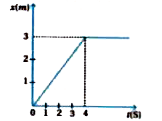
View SolutionA person driving a car suddenly applies the brakes on seeing a child on the road ahead. If he is not wearing seat belt, he falls forward and hits his head against the steering wheel. Why
View SolutionThe velocity of a body of mass 2 kg as a function of t is given by `v(t) = 2t hati + t^(2)hatj` . Find the momentum and the force acting on it, at time t = 2s.
View SolutionA block placed on a rough horizontal surface is pulled by a horizontal force F. Let f be the force applied by the rough surface on the block. Plot a graph of f versus F.
View SolutionWhy are porcelain objects wrapped in paper or straw before packing for transportation ?
View SolutionWhy does a child feel more pain when she falls down on a hard cement floor, than when she falls on the soft muddy ground in the garden ?
View SolutionA women throws an object of mass 500 g with a speed of 25 ms- 1 .
(a) W hat is the im pulse im parted to the object ?
(b) If the object hits a wall and rebounds with half the original speed, what is the change in momentum of the object ?
View SolutionWhy are mountain roads generally made winding upwards rather than going straight up ?
View SolutionA mass of 2 kg suspended with thread AB (figure). Thread CD of the same type is attached to the other end of 2 kg mass. Lower thread is pulled gradually, harder and harder in the downward direction, so as to apply force on AB.
Which of the threads will break and why ?
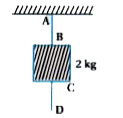
View SolutionIn the above given problem if the lower thread is pulled with a jerk, what happens
View SolutionTwo masses of 5 kg and 3 kg are suspended with help of massless inextensible strings as shown in figure. Calculate `T_(1)` and `T_(2)` when whole system is going upwards with acceleration = 2 `m/s^(2)` 2 (use g = 9.8 `ms^(-2)`).
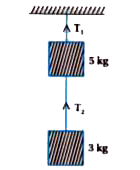
View SolutionBlock A of weight 100 N rests on a frictionless inclined plane of slope angle `30^(@)`. A flexible cord attached to A passes over a frictionless pulley and is connected to block B of weight w. Find the weight w for which the system is in equilibrium

View SolutionA block of mass M is held against a rough vertical well by pressing it with a finger. If the coefficient of friction between the block and the wall is jx and acceleration due to gravity is g, calculate the m inim um force required to be applied by the finger to hold the block against the wall.
View SolutionA 100 kg gun fires a ball of 1 kg horizontally from a cliff of height 500 m. It falls on the ground at a distance of 400 m from bottom of the cliff. Find the recoil velocity of the gun. (acceleration due to gravity = 10 `ms^(-2)` )
View Solution(x, t), (y, t) diagram of a particle moving in 2-dimensions
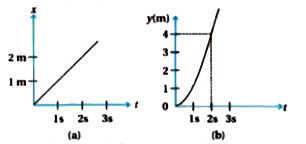 If the particle has a mass of 500 g, find the force (direction and magnitude) acting on the particle.
If the particle has a mass of 500 g, find the force (direction and magnitude) acting on the particle.
View SolutionA person in an elevator accelerating upwards with an acceleration of `2 m/s^(2)`, tosses a coin vertically upwards with a speed of `20 ms^(-1)` . After how much time will the coin fall back into his hand ? (g = 10 `ms^(2)`)
View SolutionThere are three forces `F_(1) F_(2)` and `F_(3)` acting on a body, all acting on a point P on the body. The body is found to move with uniform speed.
(a) Show that the forces are coplanar.
(b) Show that the torque acting on the body about any point due to these three forces is zero.
View SolutionWhen a body slides down from rest along a smooth inclined plane making an angle of `45^(@)` with the horizontal, it takes time T. When the same body slides down from rest along a rough inclined plane making the same angle and through the same distance, it is seen to take time pT, where p is some number greater than 1. Calculate the coefficient of friction between the body and the rough plane.
View Solution`(v_(x) ,t)`, and `(v_(y) t)` diagram for a body of unit mass. Find the force as a function of time.
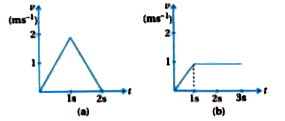
View SolutionA racing car travels on a track (without banking) ABCDEFA. ABC is a circular arc of radius 2 R. CD and FA are straight paths of length R and DEF is a circular arc of radius R = 100 m. The coefficient of friction on the road is `mu = 0.1`. The maximum speed of the car is `50 ms^(-1)`. Find the minimum time for completing one round.
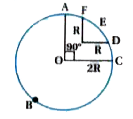
View SolutionThe displacement vector of a particle of mass m is given by r(t) = `hati A cos omegat + hatj B` sin `omegat`.
(a) Show that the trajectory is an ellipse.
(b) Show that `F= momega^(2)r`
View SolutionA cricket bowler releases the ball in two different ways (a) giving it only horizontal velocity, and (b) giving it horizontal velocity and a small downward velocity.
The speed Vs at the
time of release is the same.
Both are released at a height H from the ground.
Which one will have greater speed when the ball hits the ground ? Neglect air resistance
View SolutionThere are four forces acting at a point P produced by strings as shown in figure. Which is at rest ? Find the forces `F_(1)` and `F_(2)` .
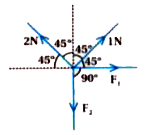
View SolutionA rectangular box lies on a rough inclined surface. The coefficient of friction between the surface and the box is `mu`. Let the mass of the box be m.
(a) At what angle of inclination 0 of the plane to the horizontal will the box just start to slide down the plane ?
(b) What is the force acting on the box down the plane, if the angle of inclination of the plane is increased to `a gt theta`
(c) What is the force needed to be applied upwards along the plane to make the box either remain stationary or just move up with uniform speed ?
(d) What is the force needed to be applied upwards along the plane to make the box move up the plane with acceleration a ?
View SolutionA helicopter of m ass 1000 kg rises with a vertical a c c ele ra tio n o f 15 `ms-^(2)` . The crew an d th e passengers weigh 300 kg. Give the magnitude and direction of the,
(a) Force on th e floor by th e crew and passengers.
(b) Action of the rotor of the helicopter on the surrounding air.
(c) Force on the helicopter due to the surrounding air.
View Solution
SECTION-D(NCERT EXEMPLAR SOLUTIONS) questions and complete solutions for chapter LAW OF MOTION of KUMAR PRAKASHAN KENDRA PHYSICS (GUJRATI ENGLISH) of Class 11
All Exercises from KUMAR PRAKASHAN Class 11 PHYSICS LAW OF MOTION
- (QUESTION PAPER) SECTION-A
- (QUESTION PAPER) SECTION-B
- (QUESTION PAPER) SECTION-C
- (QUESTION PAPER) SECTION-D
- SECTION -B (ADDITIONAL EXERCISE )
- SECTION -B (NUMERICAL FROM DARPAN BASED ON TEXTBOOK)
- SECTION -B (NUMERICAL FROM TEXTUAL EXERCISE)
- SECTION -B (NUMERICAL FROM TEXTUAL ILLUSTRATION)
- SECTION -E(MULTIPLE CHOICE QUESTIONS) (MCQS)
- SECTION-A(QUESTION PAPER)
- SECTION-A(TRY YOURSELF)(VSQS)
- SECTION-C(OBJECTIVE QUESTIONS) (VSQS)
- SECTION-D(NCERT EXEMPLAR SOLUTIONS)
- SECTION-F (QUESTIONS FROM MODULE)